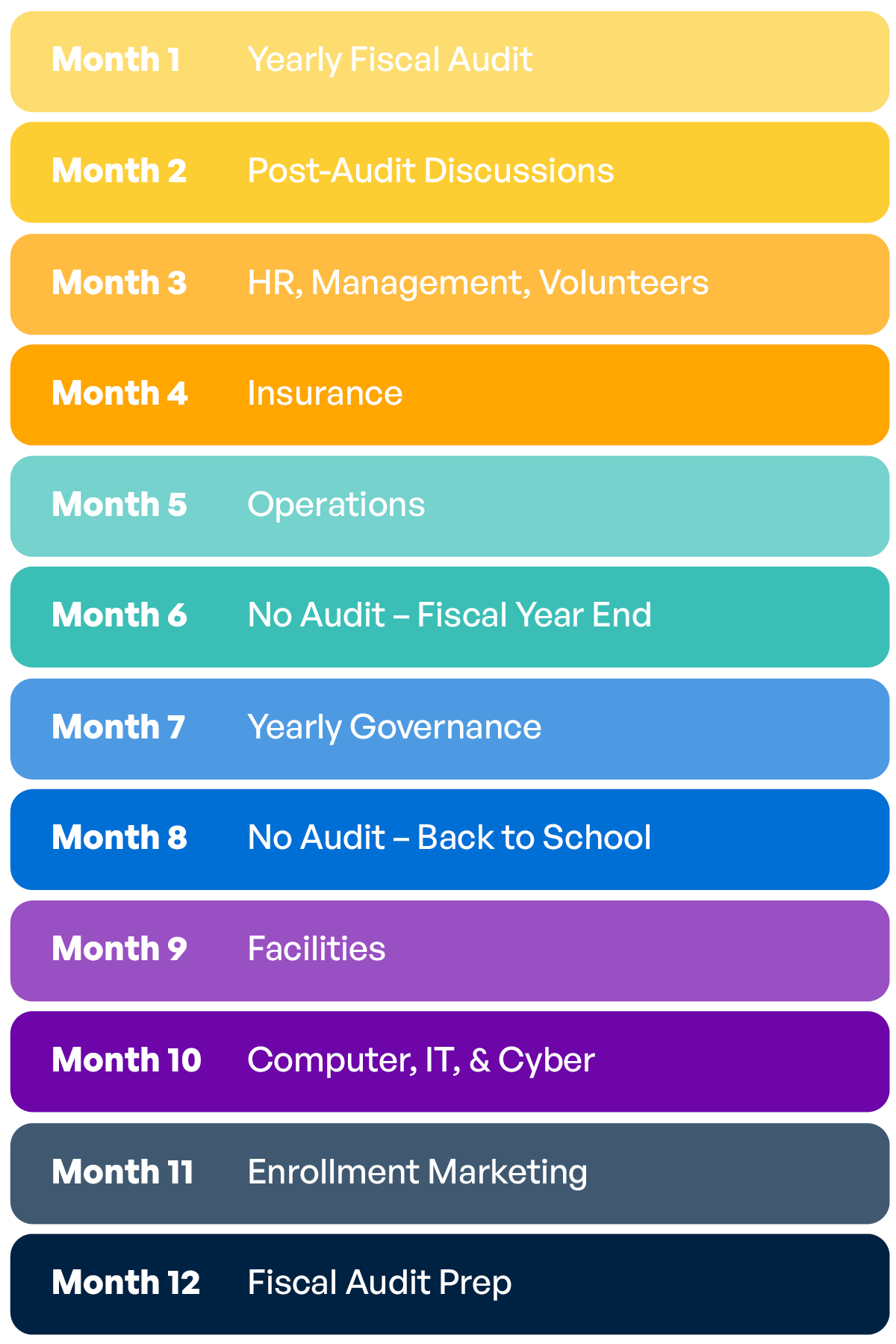
Resource Guide
The Charter School Audits Guide: Prepare for the Annual Audit
The thought of a charter school audit can be stressful. This guide provides a month-by-month preparation plan to help you navigate it with confidence.
Download Full Guide for FreeMonth-by-Month Planning
Audits can feel overwhelming—but by preparing a little each month, you can offset that feeling. To help simplify the process, we’ve broken a year’s worth of audit information into monthly internal reviews. Having a smaller project each month will help you stay organized, and so you feel empowered when the audit rolls around.
Note: These items don’t necessarily need to be done in this order, and you can move the months around based on when your yearly audit is due. Here is an example schedule.

Month 1
This month, you’ve just completed your most recent audit, so first steps are about how to move forward from there.
You’ll want to:
- Review your previous audit with your auditor. Your audit review is a great opportunity to discuss ways you can improve your school with the auditor. Look over your financial statements together and be sure to take notes.
- Review feedback with your audit committee. Take the auditor’s advice and comments back to your audit committee. Discuss the good, the bad, and the ugly.
- Present the auditor’s findings to your governing board. Go over the auditor’s findings and answer any questions from the board members. Tip: After presenting, ensure you get a copy of the minutes so you can reference them when necessary.
- Submit your audit to your authorizer. Be transparent with your authorizer, but also let them know that you and your colleagues are working on any improvements based on the feedback you received during the audit process.
- Prepare your audit message. Reflecting on these conversations, prepare your audit message for a wider audience. You’ll want to make sure your message is clear, detailed, and anticipates the questions your audience might have.
- Post your audit and audit report. Make your audit message into a web post for community visibility.
- Get ready to make a plan in Month 2!

Month 2
It’s time for a post-audit reflection. This month you will discuss the things that went well and things that need improvement for the coming year.
Tips for your planning:
- Be proactive. You want to think thoroughly about the steps your organization should take before next year’s audit.
- Think through the auditor’s recommendations for your school. What internal controls did they suggest you add? Are there new policies or procedures that need to be put into place? What could use improvement? How could you manage finances differently?
- Be sure your corrective action plan (CAP) is up-to-date. This will ensure you’re your plans are ready to go when it’s time to submit to your authorizer. Note: Not every school has a CAP or will receive one from audit results, so check with your authorizer.

Month 3
Month 3 is a big month! This month you will thoroughly examine your HR department.
Tip: This doesn’t necessarily have to be done in Month 3, but it works well to do it in spring—when teachers make plans for the next year and can inform you whether they will be returning.
There are several parts to the internal review this month, so, if possible, divide the work between several people.
During the HR review, you’ll want to:
- Review employee policies and procedures. This is your opportunity to go over contracts and agreements for the upcoming school year. Include arrangements for management, teachers, and other staff.
- Standardize roles and creating employee pay schedules. Completing this together with revising your contracts will save time. It will also provide continuity and prevent discrimination.
- Have your attorney or insurance carrier review your documents for compliance.Tip: Look into employee recruiting and hiring software to streamline your hiring process. Some full-service Back Office Providers (BOPs) even offer fingerprinting management.
- Organize Personnel and Confidential files. When your auditor shows up for their yearly visit, they will most likely want to see some of your employee files. You want to ensure that you have both physical and digital copies of these files to be easily accessible.
- Update your HR Handbook. Attend an HR law update meeting. These are a great way to brush up your HR policies. Some are free, usually occurring at the beginning of the calendar year. Check with local law firms, insurance organizations, or your Charter Association to see when the law update meeting takes place in your area.
-
- Review, redraft, and add new laws to your HR Handbook.
-
- Send your updated HR Handbook to your insurance provider for review and updating. Tip: Many insurance companies offer a once-yearly update for free and they can look it over for compliance.
-
- Share your updated handbook with your governing board for approval.

Success Story
See Success StoriesSTARS Charter School
STARS partnered for money to run their school. They were able to embark upon building projects with minimal disruptions to their thriving programs. With the new, improved space, STARS has been able to dramatically increase enrollment.
View Case Study
Need money to run your school?
Get Started- Talk to a real person
- Get qualified in minutes
- Fund your school